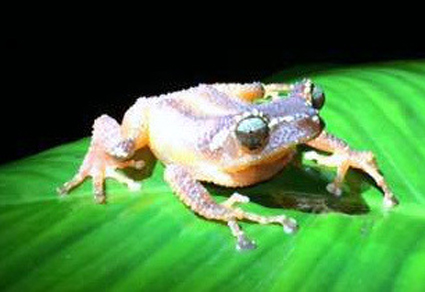References
- Boulenger, G.A. (1882) V.—Description of a new genus and species of frogs of the family Ranidae. Annals and Magazine of Natural History, Series 5, 10 (55), 35. https://doi.org/10.1080/00222938209459662
- Bush, S.L., Dyson, M.L. & Halliday, T.R. (1996) Selective phonotaxis by males in the Majorcan midwife toad. Proceedings of the Royal Society of London. Series B: Biological Sciences, 263 (1372), 913–917. https://doi.org/10.1098/rspb.1996.0135
- Capranica, R.R. (1965) n.k. In: The evoked vocal response of the bullfrog: A study of communication by sound. Research Monograph 33. MIT Press, Cambridge, Massachusetts, pp. 29–54.
- Castellano, S. & Rosso, A. (2006) Variation in call temporal properties and female preferences in Hyla intermedia. Behaviour, 143 (4), 405–424. https://doi.org/10.1163/156853906776240650
- Centre For Conservation Bioacoustics. (2019) Raven Pro: Interactive sound analysis software. Version 1.6. 1. Computer software. The Cornell Lab of Ornithology. https://ravensoundsoftware.com/ (accessed 5 January 2024)
- Dubois, A. (1981) List of nominal genera and subgenera De Ranoidea (Anura amphibians) of the world, With Identification of their species-types. Nomenclatural consequences. Pubblicazioni Del Centro Di Studio Per La Faunistica Ed Ecologia Tropicali Del C.N.R. CCXVI. Monitore Zoologico Italiano, Supplemento, 15 (1), 225–284. https://doi.org/10.1080/03749444.1981.10736637
- Emmrich, M., Vences, M., Ernst, R., Köhler, J., Barej, M.F., Glaw, F., Jansen, M. & Rödel, M.O. (2020) A guild classification system proposed for anuran advertisement calls. Zoosystematics and Evolution, 96 (2), 515–525. https://doi.org/10.3897/zse.96.38770
- Faggioni, G., Souza, F., Uetanabaro, M., Landgref-Filho, P., Furman, J. & Prado, C. (2017) Reproductive biology of the nest building vizcacheras frog Leptodactylus bufonius (Amphibia. Anura. Leptodactylidae). Including a description of unusual courtship behaviour. Herpetological Journal, 27 (1), 73–80.
- Gerhardt, H.C. & Bee, M.A. (2007) Recognition and localisation of acoustic signals. In: Narins, P.M., Feng, A.S., Fay, R.R. & Popper, A.N. (Eds.), hearing and sound communication in amphibians. Springer, New York, pp. 113–146. https://doi.org/10.1007/978-0-387-47796-1_5
- Inger, R.F. (1966) The Systematics and Zoogeography of The Amphibia of Borneo. Fieldiana Zoology, 52, 349–352. https://doi.org/10.5962/bhl.title.3147
- Iskandar, D.T. (1998) The Amphibians of Java and Bali. Bogor, Indonesia: Research and Development Centre for Biology—LIPI and GEF Biodiviersity Collections Project, pp. 83–85.
- Köhler, J., Jansen, M., Rodríguez, A., Kok, P.J.R., Toledo, L.F., Emmrich, M., Glaw, F., Haddad, C.F.B., Rödel, M.O. & Vences, M. (2017) The Use of Bioacoustics in Anuran Taxonomy: Theory. Terminology. Methods And Recommendations for Best Practice. Zootaxa, 4251 (1), 1–124. https://doi.org/10.11646/zootaxa.4251.1.1
- Kurniati, H. & Hamidy, A. (2017) Advertisement Calls Variation on Hylarana nicobariensis (Stoliczka, 1870) of Five Different Populations in Indonesia (Anura: Ranidae). Indonesian Journal of Biology, 12 (2), 165–173. [unknown pagination]
- Matsui, M. (1996) Call Characteristics and Systematic Relationships of a Malayan Treefrog Nyctixalus pictus (Anura, Rhacophoridae). Herpetological Journal, 6 (2), 62–64.
- Priambodo, B., Firmansyah, R., Pranata, D.C., Aninnas, A.N., Susanto, M.A.D., Aji, F.D.N., Widodo, T.W., Gunawan, G., Permana, D., Adiba, F.Y., Ristanto, Y., Erfanda, M.P. & Kadafi, A.M. (2021) Rediscovery of pearly tree frog, Nyctixalus margaritifer Boulenger, 1882 (Amphibia: Rhacophoridae) from Mt. Wilis after 135 years. Turkish Journal of Zoology, 45 (4), 329–334. https://doi.org/10.3906/zoo-2104-22
- Rumanta, M., Kunda, R.M. & Iryani, K. (2019) Diversity and Species composition of anura in telaga warna nature conservation, west java, Indonesia. International Journal of Zoology Studies, 4 (5), 35–40.
- Schlaepfer, M.A. & Figeroa-Sandí, R. (1998) Female Reciprocal Calling in a Costa Rican Leaf-Litter Frog, Eleutherodactylus podiciferus. Copeia, 1998 (4), 1076–1080. https://doi.org/10.2307/1447362
- Sueur, J., Aubin, T. & Simonis, C. (2008) Seewave, a free modular tool for sound analysis and synthesis. Bioacoustics, 18, 213–226. https://doi.org/10.1080/09524622.2008.9753600
- Willaert, B., Suyesh, R., Garg, S., Giri, V.B., Bee, M.A. & Biju, S.D. (2016) A unique mating strategy without physical contact during fertilization in Bombay Night Frogs (Nyctibatrachus humayuni) with the description of a new form of amplexus and female call. PeerJ, 4, e2117. https://doi.org/10.7717/peerj.2117


